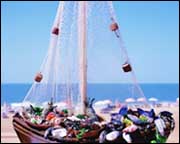


 Look at what came sailing down the harbour and into Chef Urbano de Rego�s net... and guess who came to lunch that afternoon! Edward H. PhipSon reports.
Look at what came sailing down the harbour and into Chef Urbano de Rego�s net... and guess who came to lunch that afternoon! Edward H. PhipSon reports. |
|
On a sunny Sunday afternoon, with white crests on the blue sea and pink bodies on the gold sand, I sat at a table in the Caravela, the Taj Village�s beach coffee shop, waiting for the other guests to arrive for an exclusive seafood lunch prepared by the world�s No. 1 Goa food chef, Urbano de Rego.
On the stone patio of the coffee shack, stood at anchor a small sailboat, filled with lobsters, prawns, pomfret, mullet, crabs, mussels and clams, oysters and squid, and the lady fish, kane. All the food spawned in the warm seas around and packed tightly together on the boat like sardines. No, not like sardines, something less fishy.
Not all from the sea, some of the fish came from the ponds of Goa, and the salt pans. They yield some of the best seafood, red snappers, baby bekti, baby shark, mullet, the black dot fish known locally as kaindoor, I do not know what its international name is. These are fishes that have grown differently, since there is no sand in the soil of the salt pans, instead there is the sticky black mud (chikkal) at the bottom of the pond, which the fish eat and grow healthy on, and the paddy that finds its way into the water from the fields around.
The fish itself is from the sea, it gets pulled into the Mandovi, and then, during the monsoon, it finds itself with the river emptying into the ponds. After the monsoon, around November, the agris of Goa dry the ponds to get at the salt, and recover some of the land�s best seafood from the bottom of the ponds.
So there I sat in the Caravella, a frosted Bloody Mary in front of me, a neat salt collar around its rim, like the dog collar of a priest from one of the hundreds of churches. Lucio Miranda, architect, guitarist and phado singer (�phado, phado, Lucio,� people call at the end of every dinner party, requesting him to sing), lurched in, one of the guests at the lunch. I have known Lucio for more than a quarter century, and he looked a little old the first time I met him, the face strained, the eyes tired. He looks old today also, but not a day older than what he did 25 years ago.
Amazing. Wife Corinne was away, flying, that�s her job, and he talked about her cooking talents. He told me that it was several years after they were married that he discovered where she had acquired her cooking talents. From her father, Lazarus Fernandes, who was the chef at the Willingdon Club in Bombay. It was at the same time as the legendary Mascarenhas was the chef at the Taj, and there was a continuous and inconclusive debate in Bombay as to who was the better chef.
But today we were in the hands of Urbano de Rego, and his sous chef at the Village, Chef Jeffrey Fernandes. They were preparing the lobster balchao, the lobster meat removed from the shell, cut into medallions, marinated in lime juice, turmeric powder, salt and sugar. The balchao, done in toddy vinegar and red masalas (no water), mixed with the meat and replaced in the shell. The stewards scooping out the balchaoed meat and putting it in our plates, vinegary - certainly, toddyish - a little, but the strong tastes not overriding the subtle flavours of the lobster meat. My compliments to the chef (chefs).
The guests were all there by then, sitting on a long table, the ramparts of the Aguada Fort on one side of them, neatly placed like a child�s building blocks, the sea in front and behind them. There was Dr. Wilfred D�Souza, former chief minister, and a minister many times over. And his wife, an Englishwoman, Grace.
We work very hard in Goa,� she told me, when I said I envied their life of sea and sand. And Dr. Sidney Pinto de Rosario, and wife, Dr. Sonia, they run the oldest private maternity home in Goa, and a 230-year-old house in Porvorim, presently occupied by the eighth generation of de Rosarios. And Dr. and Dr. Subodh and Savita Kerkar, he a medical man who has given up practice and become a famous painter, and she a professor of marine biology at the National Institute of Oceanography.
We had clams xec-xec, picking the clams up with our fingers, then wiping the soiled fingers on the napkins. This, after all, was Goa. The chef, thankfully, had removed one of the two shells to make the meat easy to get at with the tongue. It was the policy of the kitchen. And the meat, thus scooped out with the tongue, danced in the mouth, a solid dot of fishy meat, the masala of browned coconuts and cloves, the tamarind paste, were incidental. The clams came from the river, the mussels from the sea.
They were rolled in semolina and shallow fried, mixed with sauted onions and coriander. The stuffed crabs were a bit misleading, because the stuffing was crab meat. The original meat, first scooped out, then marinated and cooked over a low flame, fed on tamarind pulp, then stuffed back into the shell.
Chef de Rego comes from Divar, the picturesque island village off Old Goa, home of Mario Cabral E Sa and George Menezes. From here de Rego set out on a 28-year journey with the Taj, with stints in Mumbai and Muscat, Goa food festivals from London to Switzerland, and the last eight years as executive chef at the Taj Village.
His sous chef, Jeffrey Fernandes, is from Arpora, a quaint village, untouched so far, he has cooked for the Shamiana at the Mumbai Taj. All the staff has grown with the Taj. Restaurant Manager Leo D�Souza has been 14 years with the group, worked at the St. James Court, London, and been manager of the Tanjore in Mumbai. Speaks fluent Italian, French, and highlight of his career is serving Nelson Mandela and J.R.D. Tata.
That takes care of the staff. The guests were settling down to the long afternoon of dining. There was lady fish coming in, fried but not oily, with a crunchy head filled with green chutney to be chewed through - the best part of the fish. And there were designer drumsticks with the lady fish, looking like asparagus.
They were talking of Dom Moraes�s article in the morning�s O�Heraldo. Dom writes a column for practically every newspaper in the country, and, instead of syndicating his column and earning more or less the same amount of money, he writes a different column for each paper. When I pointed out to the guests this foible of Goa�s favourite son, the former chief minister pointed out: �That�s because Goans are impractical, we have no business head.� Somebody else pointed out an exception - Remo Fernandes.
Though he lived in a small village, he was connected across the country and he had the most sophisticated studio in India. He also played five instruments, and since there is a drain of musicians in Goa, he played all the instruments himself on separate tracks, then joined them together for his albums. So, if you bought a Remo album, it was Remo, from A to Z.
And we talked of food. Lucio Miranda said that half the Goa cuisine had disappeared because nobody cooked beef and pork any more. A dozen dishes were lost, the emphasis had definitely shifted to seafood. And Dr. Savita Kerkar talked of Hindu Goa food. They did not use vinegar, they used kokum instead, and tamarind, and they did not use jeera at all in their non-vegetarian food, Catholics used a lot of it. Also, they fried their fish in a batter.
And though they ate meat, like the Catholic Goans, they had a lot of vegetable dishes, including khatkhatte, made during Ganesh Chaturthi from root vegetables, including sweet potatoes, pumpkin, elephant foot. And sol kadhi, that most wonderful of wonderful drinks, coconut milk and kokum juice. They had it at the end of the meal, sol kadhi and rice, eating it with their hands, to get rid of the smell of fish curry from their hands.
Not that all this really matters. Both the Catholic and Hindu Goan food in Goa are outstanding. And, as further proof, at Madhav Ashram, the state�s most famous Hindu Goan restaurant, in Panaji, behind Hotel Mandovi, the cook at present is a Catholic, I understand.
Meanwhile, more food was coming out of the kitchen. Tiger prawns peri peri, large and juicy and perfectly grilled. And two types of pomfrets, a pomfret rechaedo, done in Goa vinegar, with whole spices and a red masala, the fish grilled on both sides, and a pomfret curry, with kokum and tamarind pulp, the curry nice and thin, unlike the Manglorean, which is a gassi with a thick onion mash.
And minced prawns in squids, with red masala and green coriander. And fresh oysters with freshly chopped coriander leaves. Enough fish to last a lifetime.And out in the sea, fishermen were doing the rampon, a long fishing net stretched across the Aguada Bay, bringing in the fish with the incoming tide. There will be more fish at the Caravela tonight.
|

Home Page
About the mag
Subscribe
Advertise
Contact Us
